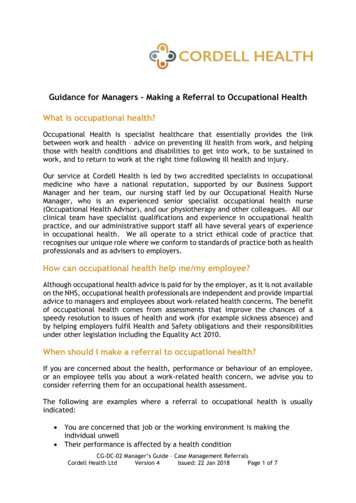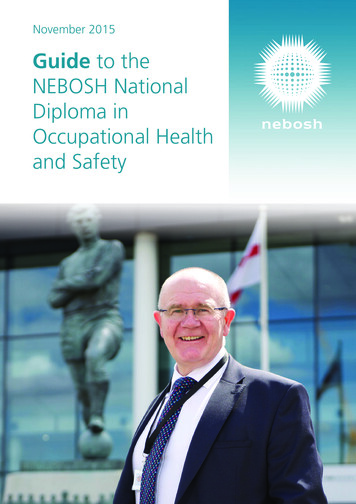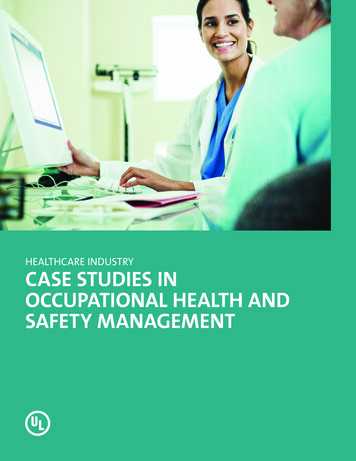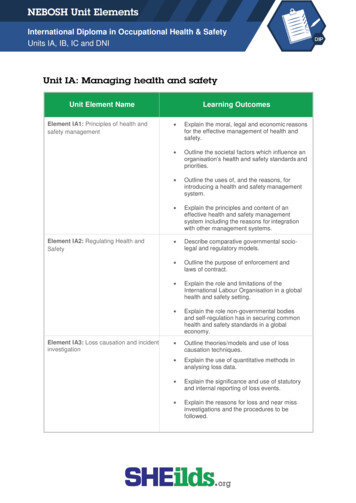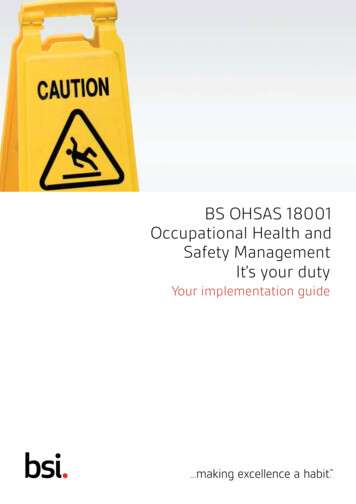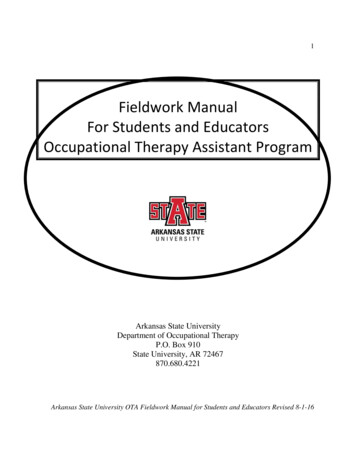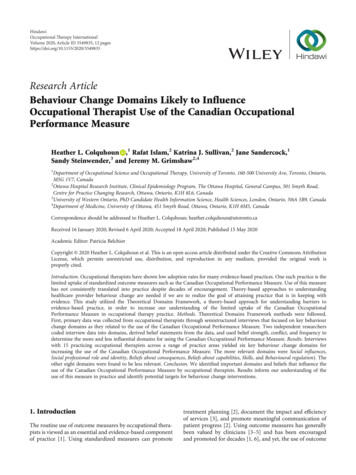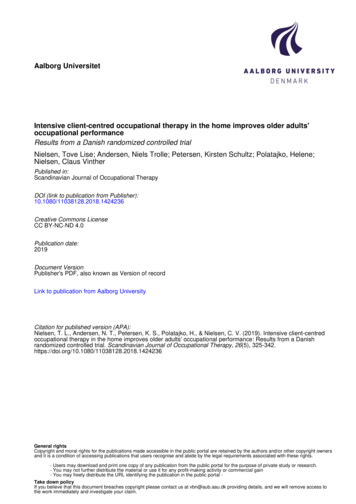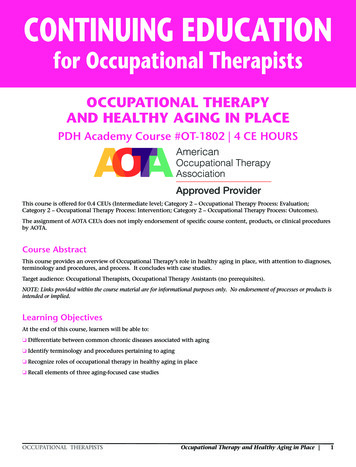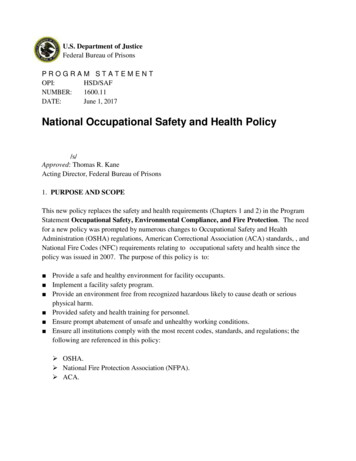
Transcription
U.S. Department of JusticeFederal Bureau of PrisonsPROGRAM STATEMENTOPI:HSD/SAFNUMBER:1600.11DATE:June 1, 2017National Occupational Safety and Health Policy/s/Approved: Thomas R. KaneActing Director, Federal Bureau of Prisons1. PURPOSE AND SCOPEThis new policy replaces the safety and health requirements (Chapters 1 and 2) in the ProgramStatement Occupational Safety, Environmental Compliance, and Fire Protection. The needfor a new policy was prompted by numerous changes to Occupational Safety and HealthAdministration (OSHA) regulations, American Correctional Association (ACA) standards, , andNational Fire Codes (NFC) requirements relating to occupational safety and health since thepolicy was issued in 2007. The purpose of this policy is to: Provide a safe and healthy environment for facility occupants. Implement a facility safety program. Provide an environment free from recognized hazardous likely to cause death or seriousphysical harm. Provided safety and health training for personnel. Ensure prompt abatement of unsafe and unhealthy working conditions. Ensure all institutions comply with the most recent codes, standards, and regulations; thefollowing are referenced in this policy: OSHA. National Fire Protection Association (NFPA). ACA.
Requirements for conditions or operations not adequately addressed by the codes andstandards referenced above may use information published by: American Society for Testing and Materials (ASTM). American National Standards Institute (ANSI). American Conference of Governmental Industrial Hygienists (ACGIH).The scope of this policy is limited to occupational safety and health requirements dealing with: Institution Security. Occupational Safety. Occupational Health.This policy applies to: BOP-owned or -operated detention and correctional facilities. UNICOR operations at BOP detention and correctional facilities.a. Summary of ChangesPolicy RescindedP1600.09Occupational Safety, Environmental Compliance, and Fire Protection (10/31/07);Chapters 1 and 2 (Safety and Health) only.Numerous changes to occupational safety/health codes, standards, and regulations have beenincorporated into this policy.b. Program Objectives. The objectives of this policy are: Evaluate unsafe or unhealthy conditions reported by facility occupants.Evaluate accidents and injuries that occur at the facility.Develop a plan of corrective action based on the evaluation of hazards and accidents.Ensure personal protective equipment is issued and used by all personnel when necessary.Conduct safety and health inspections/audits, as specified in this policy.Conduct hazard assessments and surveys, as specified in this policy.Minimize the possibility of accidents, deaths, and illnesses.Encourage facility occupants to report workplace hazards.Ensure that safety is a principal element in all BOP operations.c. Institution Supplement. Each facility must develop an institution supplement on footprotection. Should local facilities make any changes outside the required changes in the nationalP1600.116/1/20172
policy or establish any additional local procedures to implement national policy, the local Unionmay invoke to negotiate procedures or appropriate arrangements.d. Written Plans and Programs. Each institution must develop the following writtenplans/programs: Control of flammable, toxic, and caustic materials. See Chapter 3, Section 4.Confined space. See Chapter 2, Section 5.Control of Hazardous Energy (Lockout/Tagout). See Chapter 2, Section 6Fall protection. See Chapter 2, Section 3.Hazard communication. See Chapter 3, Section 3.Hearing conservation. See Chapter 3, Section 8.Hot work. See Chapter 2, Section 14.Pest control. See Chapter 3, Section 10.Respiratory protection. See Chapter 3, Section 2.REFERENCESProgram StatementsP1600.12National Environmental Protection Policy (6/1/2017)P1600.13National Fire Protection Policy (6/1/2017)P1601.05Workers’ Compensation Programs (3/25/16)P4200.11Facilities Operations Manual (4/12/16)P5500.14Correctional Services Procedures Manual (8/1/16)BOP FormsBP-A0139BP-A0140BP-A0169BP-A0506BP-A0658Other FormsOSHA 300OSHA 300aOSHA 301SF-91SF-94SF-95P1600.11Notice of Right to File for Compensation for a Work-Related InjuryInjury Report – InmateUniform Basic Safety RegulationsInstitution Fire/Safety and Sanitation InspectionInmate Claim for Compensation Resulting from Work InjuryLog of Work-Related Injuries and IllnessesSummary of Work-Related Injuries and IllnessesInjury and Illness Incident ReportMotor Vehicle Accident ReportStatement of WitnessClaim for Damage, Injury, or Death6/1/20173
ACA Standards American Correctional Association Standards for Adult Correctional Institutions, 4th Edition:4-4082, 4-4145, 4-4146, 4-4211, 4-4212, 4-4215, 4-4329, 4-4332, 4-4333, 4-4358, and 4-4413 American Correctional Association Performance Based Standards for Adult Local DetentionFacilities, 4th Edition: 4-ALDF-1A-01M, 4-ALDF-1A-03M,4-ALDF-1A-04, 4-ALDF-1A14,4-ALDF-1A-16, 4-ALDF-1C-08M,4-ALDF,1C-09M, 4-ALDF-1C-11M, 4-ALDF-4C18M, and 4-ALDF-4D-26 American Correctional Association Standards for Administration of Correctional Agencies,2nd Edition: 2C0-2A-02, 2C0-1D-15, and 2C0-3B-01 American Correctional Association Standards for Correctional Training Academies: 1CTA2B-01, 1CTA-2B03, 1CTA-3B-06, 1CTA-3C-05 1CTA-3E-03, 1CTA-3E-04, and 1CTA-3E05Records Retention RequirementsFor guidance on records and information that apply to this program, see the Records andInformation Disposition Schedule (RIDS) on Sallyport.P1600.116/1/20174
CONTENTSChapter 1. Administration .71. Occupational Safety and Health Duties.72. Environmental/Fire/Safety Training Records.113. Occupational Safety and Health Training Requirements .124. Institution Safety Committee .135. Inspections .136. Technical Assistance Visits .147. Reporting Hazards.148. OSHA Poster.159. Accidents .1510. Reports .1611. External Agency Visits .1612. Inmate Injury Investigation .1713. Construction and Renovation Projects .1814. Driver Licensing.1815. Seat Belt Use .1916. Distracted Driving .19Chapter 2. Occupational Safety .201. Hazard Assessment .202. Firing Ranges .213. Walking-Working Surfaces .214. Painting Operations .235. Confined Space Program.236. Control of Hazardous Energy (Lockout/Tagout) .257. Tire Service .278. Powered Industrial Trucks .289. Personnel Lifts (Aerial Lifts/Scissor Lift/Boom Truck) .3010. Machine Guarding.3111. Cleaning With Compressed Air . 3212. Lawn Equipment .3213. Welding, Cutting, and Brazing.3214. Hot Work Plan .3315. Electrical .3416. Excavations/Trenching .3617. Compressed Gas Storage.3618. Chlorination Rooms .3719. Kilns .3720. Portable Power Tools and Hand-Held Equipment .3721. Cranes.3822. Transportation .38P1600.116/1/20175
Chapter 3. Occupational Health .401. Injury Recordkeeping .402. Respiratory Protection .413. Hazard Communication.444. Chemical Control and Accountability .455. Toxic And Hazardous Substances and Lead .456. Eye Wash Stations and Showers .487. Ventilation .488. Noise .499. Lighting .5210. Pest Control.5311. Security X-Ray Machines .54P1600.116/1/20176
ACRONYMS AND American Correctional AssociationAmerican Conference of Governmental Industrial HygienistsAssistant DirectorAmerican Society for Testing MaterialAmerican National Standard InstituteFederal Bureau of PrisonsCommercial Drivers LicenseChief Executive OfficerCode of Federal RegulationsU.S. Department of LaborU.S. Department of JusticeU.S. Department of TransportationEnvironmental and Safety Compliance AdministratorFederal Insecticide, Fungicide, and Rodenticide ActGround Fault Circuit InterrupterHealth Services DivisionHeating, Ventilation, and Air ConditioningInmate Accident CompensationNational Environmental and Safety Compliance AdministratorNational Institute for Occupational Safety and HealthNational Fire Protection AssociationNational Fire CodesNotice of ViolationNuclear Regulatory CommissionOccupational Safety and Health AdministrationOffice Personnel ManagementPermissible Exposure LimitPersonal Protective EquipmentRegional DirectorRegional Environmental and Safety Compliance AdministratorSelf-Contained Breathing ApparatusSpecial Housing UnitSafety Data SheetTraining-for-TrainersThreshold Planning QuantityToxic Substance Control ActUnderwriters’ LaboratoriesVocational Training6/1/20177
Chapter 1. Administration1. OCCUPATIONAL SAFETY AND HEALTH DUTIESa. Assistant Director. The Assistant Director (AD), Health Services Division (HSD), isdesignated as the Health and Safety Official for the Federal Bureau of Prisons (BOP).b. National Environmental and Safety Compliance Administrator. The NationalEnvironmental and Safety Compliance Administrator (NESCA), reports to the AD, HSD, onissues relating to occupational safety. He/she: Oversees the management of the BOP’s occupational safety and health program. Supervises the Chief, Occupational Safety Compliance. Provides technical direction to Regional Environmental and Safety ComplianceAdministrators (RESCA). Interprets the BOP Occupational Safety and Health Policy. Provides guidance and technical assistance to Central Office, Regional, and institution staffto resolve OSHA issues that cannot be resolved at the institution or regional levels.c. Chief, Occupational and Employee Health. The Chief, Occupational and Employee Health,reports to the AD, HSD, on issues relating to occupational health. He/she: Oversees the management of the Bureau’s occupational health program.Interprets the Bureau’s Occupational Health requirements within this policy.Supervises the Occupational and Employee Health Branch.Provides technical direction to RESCAs on occupational health issues.Provides guidance and technical assistance to Central Office, Regional, and institution staffto resolve occupational health issues that cannot be resolved at the institution or regionallevels.d. Chief, Occupational Safety Compliance. The Chief, Occupational Safety Compliance,reports to the NESCA on issues relating to occupational safety. He/she: Oversees the daily operation of the Bureau’s occupational safety program.Interprets the Bureau’s Occupational Safety requirements within this policy.Serves as the BOP point of contact for OSHA visits to institutions.Notifies RESCAs of scheduled OSHA visits.Serves as a technical resource in the area of: OSHA-related programs. OSHA citations and complaints. OSHA compliance audits.P1600.116/1/20178
Provides guidance and technical assistance to Central Office, regional, and institution staffto resolve OSHA issues that cannot be resolved at the institution or regional levels.e. Regional Environmental and Safety Compliance Administrator. The RegionalEnvironmental and Safety Compliance Administrator (RESCA), reports to the Regional Director(RD) on issues relating to occupational safety and health. He/she, in conjunction with theNational Environmental and Safety Compliance Branch and the Occupational and EmployeeHealth Branch: Provides direction and technical assistance to help resolve occupational safety and healthissues that cannot be resolved at the institution level. Conducts technical assistance visits to institutions. Assists institutions with timely OSHA injury and illness reporting requirements. Monitors the effectiveness and uniformity of Regional occupational safety and healthprograms. Monitors reports and other occupational safety and health data generated by institutionpersonnel. Notifies the NESCA of OSHA citations and complaints and forwards the citation andcomplaints to the Chief, Occupational Safety Compliance. Monitors occupational safety and health reports to identify and track: Safety trends.ACA Accreditation and Reaccreditation issues.Program Review findings.Operational review findings.OSHA citations and complaints.OSHA injury and illness reporting requirements.Training needs.Injury rates. Assists in conducting institutional OSHA Compliance Audits. Serves as the regional technical resource for emergency response procedures involvingnatural disasters, chemical, biological, radiological/nuclear, and explosive incidents. Monitors Program Review findings relating to occupational safety and health issues. Identifies and assists in the implementation of corrective actions to address Program Reviewfindings. Assists institutions in the implementation of SCBA fit test and training programs. Serves as the Regional technical resource for emergency response procedures involvingoccupational safety and health emergencies. Provides quarterly updates to the NESCA and Chief, Occupational Safety Compliance on:P1600.116/1/20179
ACA visits.Government Owned Vehicle accidents.Program Reviews.Regional occupational safety and health initiatives.Safety incidents.Status of corrective action on OSHA citations and complaints.Updates on serious injuries and hospitalizations.f. Certified Industrial Hygienist (Central Office). The Central Office Certified IndustrialHygienist reports to the Chief, Occupational and Employee Health, on issues relating tooccupational health and industrial hygiene. He/she: Provides occupational safety and health consultation to Institutional and Regional ESCAs(e.g., indoor air quality, workplace mold, and other workplace and industrial hygienestressors). Reviews Safety Data Sheets and provides Hazard Communication guidance for Job HazardAssessments for FPI and BOP facilities. Develops scopes of work for industrial hygiene contractors and reviews contractor reports fortechnical accuracy and recommendation effectiveness. Recommends effective and appropriate PPE for staff/inmate use. Assists in drafting responses to regulatory agencies (i.e., OSHA) regarding workplace healthand safety issues. Provides guidance on potentially hazardous new chemicals, processes, or operations within thecorrectional environment for FPI and BOP facilities. Assists and provides Chief, Occupational and Employee Health, with technical input forindustrial hygiene policies. Collects and analyzes injury surveillance data of workplace injuries. Must maintain American Board of Industrial Hygiene (ABIH CIH) certification required forduties.g. Occupational Safety Compliance Specialist (Central Office). The Central OfficeOccupational Safety Compliance Specialist reports to the Chief, Occupational SafetyCompliance, on issues relating to occupational safety. He/she serves as a technical resource toCentral Office, Regional, and institution staff in the areas of: OSHA-related programs.OSHA citations and complaints.Bureau policy relating to occupational safety and health.Occupational safety and health training.Accident investigation.P1600.116/1/201710
He/she will be called on to participate in: After-action reviews.Data collection.Development and delivery of occupational safety and health training.Responses to OSHA citations and complaints.Occupational safety work groups.OSHA compliance audits.ACA accreditation and reaccreditations.Project plan and specification review.Technical assistance visits.h. Environmental and Safety Compliance Administrator (ESCA). The Environmental andSafety Compliance Administrator (ESCA) advises the institution Chief Executive Officer (CEO)on occupational safety and health issues. He/she works at the department head level with otherinstitution managers to achieve safety goals. When policy and regulations are not specific,he/she must exercise professional judgment to maintain a reasonable level of occupational safetyand health protection at the institution. He/she serves as the institution’s technical resource foremergency response procedures involving accidents, injuries, deaths, and similar emergencies.i. Other Environmental and Safety Compliance Personnel (Institution). OtherEnvironmental and Safety Compliance Department staff report to the ESCA and assist in theimplementation of the institution’s occupational safety and health program.j. Environmental and Safety Compliance Administrator Trainee. The Environmental andSafety Compliance Administrator Trainee advises the institution ESCA on occupational safetyand health issues. He/she works with the ESCA and other institution managers to achieve safetygoals. When policy and regulations are not specific, he/she must exercise professional judgmentto maintain a reasonable level of occupational safety and health protection at the institution.k. Environmental and Safety Compliance Alternates. If the institution ESCA is the only fulltime Environmental and Safety Compliance Department staff member, the CEO must appoint atleast one safety alternate to provide department coverage during the ESCA’s absence. The CEOat an institution with two or more full-time Environmental and Safety Compliance Departmentstaff is highly encouraged to appoint one or more safety alternates.l. Chief Executive Officers. The Chief Executive Officer (CEO) must: Support institution occupational safety and health program initiatives. Monitor the effectiveness of the institution occupational safety and health program.P1600.116/1/201711
Ensure adequate Environmental and Safety Compliance Department staffing to administerthe institution occupational safety and health program. Ensure compliance with this policy and applicable safety and health regulations/standards. Ensure periodic occupational safety and health inspections of the facility are conductedby technically competent personnel. Ensure prompt abatement of unsafe and/or unhealthful working conditions. Ensure accurate recordkeeping for occupational safety and health issues. Ensure that adequate occupational safety and health training is provided to management,supervisory, safety, and collateral duty safety personnel, as well as all other institutionpersonnel. Ensure employees are not subject to restraint, interference, coercion, discrimination, orreprisal for exercising their rights under, or participating in, the Bureau’s occupational safetyand health program and OSHA regulations. Ensure all staff are adequately trained in safety and health initiatives.m. Supervisors. All supervisors must: Perform their duties in the safest possible manner.Ensure safety practices are followed and implement corrective actions.Ensure personnel are trained in occupational safety and health.Comply with this policy. Familiarize themselves with hazards in particular jobs or the physical surroundings ofemployees. Ensure that personnel are aware of the hazards in particular jobs. Immediately report all injuries, accidents, or similar emergencies to the Environmental andSafety Compliance Department. Ensure that injured personnel receive appropriate medical attention. Ensure that accident and injury reports are completed.n. Employees. Employees must: Perform their duties in the safest possible manner. Comply with this policy. Immediately report all incidents, injuries, illnesses, or similar emergencies to theirsupervisors and the Environmental and Safety Compliance Department. Immediately report hazards or unsafe acts to their supervisors and/or to the ESCA. Complete necessary forms for injuries or illnesses.2 . IMMINENT DANGER. When a member of the Environmental and Safety ComplianceDepartment determines that conditions or practices could reasonably and immediately beP1600.116/1/201712
expected to cause death or serious physical harm, he/she must inform affected employees of thedanger and shut down the area, work, or process until the danger is eliminated.Written notification of an imminent danger determination, identifying both the hazardousconditions and actions taken, must be submitted to the CEO, RESCA, NESCA, and local UnionPresident or designee.The area, work, or process may be reopened/restarted only after the ESCA conducts aninspection and provides written approval. A copy of the written approval must be provided tothe CEO, RESCA, NESCA, and local Union President or designee.The RESCA and NESCA must review all actions taken as a result of an imminent dangerdetermination.3. ENVIRONMENTAL/FIRE/SAFETY TRAINING RECORDSAll records for Environmental/Fire/Safety training conducted at the institution must bemaintained by the department providing the training.4. OCCUPATIONAL SAFETY AND HEALTH TRAINING REQUIREMENTSa. Environmental and Safety Compliance Department Staff. Environmental and SafetyCompliance Department staff must complete the following training: Electrical Standards (OSHA 3095).Machinery and Machine Guarding Standards (OSHA 2045).OSHA Guide to Industrial Hygiene (OSHA 521).OSHA Standards for Construction (OSHA 510).OSHA Standards for General Industry (OSHA 511).Permit-Required Confined Space Entry (OSHA 2264).Respiratory Protection (OSHA 2225).b. All Staff (Institution). Institution staff must be trained during Introduction to CorrectionalTechniques Phase I and Annual Training in the following: Asbestos awareness.Confined Space Identification.Energy Control Program (Lockout/Tagout).Hazard Communication Program.Hearing Conservation Program.Conducting inmate safety training.P1600.116/1/201713
Monthly/weekly departmental inspections. Respiratory Protection Program.c. Administrators, Managers, and Supervisors (Institution Duty Officers). Alladministrators, managers, and supervisors must be trained annually in inspection techniquesneeded to determine compliance with the following requirements: Applicable occupational safety and health regulations and standards. This policy.d. Inmate Training. Each inmate must receive familiarization training during InstitutionAdmission and Orientation on occupational safety and health programs. He/she must sign theforms BP-A0169, Uniform Basic Safety Regulations, and BP-A0139, Notice of Right to File forCompensation for a Work-Related Injury. A copy of each form must be placed in the InmateCentral File.Upon assignment to a job or detail, each inmate must receive initial training by his/her supervisorconcerning safe work methods and hazardous materials. Refresher training must be providedannually or whenever there is a work process change. At a minimum, training must includedemonstration of safety features and practices. Workers must be trained to recognize hazardsinvolved in the workplace, understand protective devices and clothing, and report deficiencies totheir supervisors. Training must be documented and signed by the inmate.5. INSTITUTION SAFETY COMMITTEEa. Institution Safety Committee Membership. The Institution Safety Committee must includedepartment heads (including the ESCA and Facilities Manager(s)) designated by the CEO,UNICOR representation, and Union representation (per the Master Agreement, Article 27).Other staff should be invited to Safety Committee meetings as needed to discuss issues involvingtheir areas.The ESCA must chair the committee and designate a recorder to prepare minutes. Minutes mustbe forwarded to the committee members, including the local Union and to the RESCA.The committee must meet quarterly. More frequent meetings may be required based on otherrequirements (e.g., Environment of Care requirements at Medical Centers). At a minimum, thefollowing topics must be reviewed: Accidents and injuries. Environmental issues as required by the Program Statement National EnvironmentalProtection Policy.P1600.116/1/201714
Fire safety issues as required by the Program Statement National Fire Protection Policy.Hazardous complaint log.Inspections.Pest Control.Operational/Program Review reports.Environmental/Fire/Safety Training.b. Work Programming Committee. The ESCA must be a member of the Work ProgrammingCommittee.6. INSPECTIONSa. Weekly Inspections. The Institution Duty Officer must inspect all areas of the institutionweekly, using form BP-A0506, Institution Fire/Safety and Sanitation Inspection.b. Monthly Inspections. All areas of the institution must be inspected monthly byEnvironmental and Safety Compliance staff.c. Annual Inspections. In addition to the monthly inspection requirement, annual inspectionsof the following must be completed and documented.(1) Sanitation Inspection. The annual sanitation inspection may be conducted by any of thefollowing: Environmental and Safety Compliance Department staf
American Society for Testing and Materials (ASTM). American National Standards Institute (ANSI). American Conference of Governmental Industrial Hygienists (ACGIH). The scope of this policy is limited to occupational safety and health requirements dealing with: Institution Security. Occupational Safety. Occupational Health.
